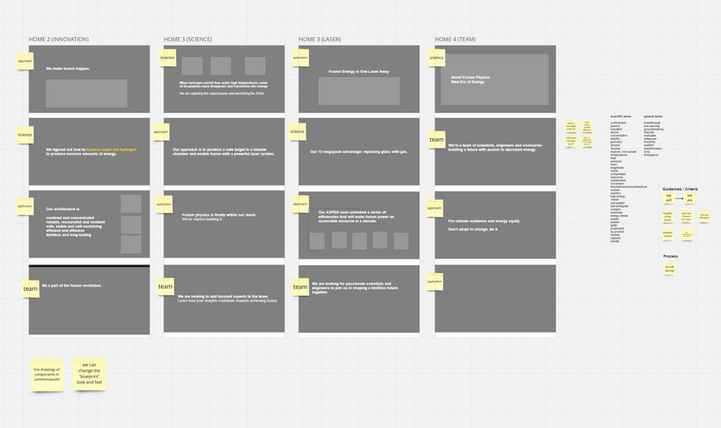Xcimer Energy
Nov 2023 - Present
Xcimer is a growing startup in the nuclear fusion energy space, with a recent series A announcement in June 2024. Our team's work at Big Dreams Studio was to learn about Xcimer's inertial fusion science and technology and use it to design, develop and deliver engagements and communications, applied to digital and print media, and a website 2.0 design.
Team
Alyssa Bishop (Strategy Director), Laila Auckee (Design Director), Arvind Bhallamudi (Strategy Lead) Jack Lenk (Production Manager), Jae Yoon Myung (Design Lead)
Role
Conducted research and competitive analysis, developed a communication strategy, crafted stories, created two data visualizations, and designed web interfaces and pages.
Services
Communication Design
Web Experience Design
Brand Identity
Storytelling
Engagement Strategy
Data Visualization

Current Scenario
Nuclear fusion promises a future with a limitless, carbon-free and reliable source of power that advances the human civilization. Inertial fusion energy (IFE) as a clean source of power for the future has been regaining attention since National Ignition Facility's net-energy gain breakthrough. Since 2024, more than $900 million was directed toward fusion technologies, with a total of $7.1 billion into the fusion industry since 1992.
NIF’s groundbreaking result was very expensive to achieve, took decades of development, and doesn’t produce enough energy gain for commercial operation. Many obstacles remain to scale this result for commercial use, including the cost of the laser. Each of NIF’s beamlines uses a series of precision glass optical elements to generate, control and precisely direct light towards the target. Because glass can only handle a certain amount of laser energy without being damaged, NIF must spread 2 megajoules of laser energy over 192 independent beamlines, at significant expense.

Img.1 On December 5, 2022, the National Ignition Facility (NIF) at Lawrence Livermore National Lab performed an experiment in which a 2.05 megajoule laser pulse yielded 3.15 megajoules of fusion energy, the first breakthrough.
Science and Technology Research
Fusion energy uses one of two main approaches: magnetic (MFE) such as tokamaks and stellarators, or inertial (IFE) that uses lasers or particle beam accelerators. IFE (Xcimer's technology) relies on compressing and heating a small fuel pellet, typically made of deuterium and tritium, using powerful lasers or particle beams to achieve rapid compression creates a shockwave that initiates the fusion reaction. These enable high temperatures and pressures that reach over 5 million degrees F and 1000 million bar.
We learnt how Xcimer is solving some of the major challenges in scaling inertial fusion, by replacing the hundreds of glass mirrors with more effective gas optics, using larger targets efficiently contained in a molten salt cooled chamber, and constructing a 10+ MJ laser for higher power yields. Learning this guided our approach to position Xcimer with an edge in the inertial fusion space, and used these learnings to show how its technology and configuration might be the most cost-effective option among all other fusion approaches.


Fig.1 Fusion reaction where mass is converted to energy
Fig.2 Detailed explanation of pellet imploding.

Fig.3 Xcimer's Pheonix facility's elements and architecture

Fig.4 Advantages that enable Xcimer's technology to be low-cost and high-throughput for commercial use.

Fig.5 Key features and goals of Xcimer's IFE system.

Sketch.1 Website content and messaging analysis of peers in the fusion startup landscape.

Fig.6 Matrix positioning across 1) messaging and science, and 2) audience and readiness.
UX/UI Prototyping
In this iterative process of further research, ideation and prototyping, exploring more of Xcimer's history, and its engineering systems, I mapped out elements, information and flows for explaining its in-depth technologies. Using this, we built a top-level navigation for the content, with layers of stories, data, and insights within each section.

Sketch.2 Wireframing and low-fidelity prototypes on Miro, later developed on Figma.

Fig.7 Information architecture for website navigation, content and menu.
Communication Strategy and Design
After discussions with the founders and team at Xcimer, as within our studio, we realized the narrative around fusion energy had to start with the reason of pursuit, the logic of systems that make it possible to execute, contextualizing humanity's energy requirements, and the scope of fusion as a realistic future energy source.
This structuring of the information in three primary sections: mission, science and approach, leads viewers from the why (mission) to the what (science) and how (approach) of Xcimer's technology.
From brand-focused (imaginative, commercial) to science-focused (rational, credible);
and techno-optimism (future casting, eager tone) to techno-realism (neutral, academic tone).

Screens.1,2,3 Heading screens of three pages on the Xcimer website: mission, science and approach.
Storytelling with Data
I proposed forming a communication approach to the purpose using historical advancements and an interactive digital interface to understand the data. To spur action around fusion energy, two data visualization sections were created to engage readers in the historical timeline that Xcimer is building on, and around the mission and the change it aims to deliver.

Sketch.3,4 Researched list of 50+ milestones in the history of fusion energy science and advancement since 1922.

Screen.4 Interactive timeline of events that led up to the development of Xcimer's fusion science and engineering.

Sketch.5,6 Storytelling approach based on Henry Adam's Curve (left) and integration with Xcimer's values (right).

Screen.6 Data visualizations for explaining the goals of inertial fusion energy from Xcimer's perspective.
Multimedia and Communications Plan
Balancing creative writing with technical information was done in parallel with the assisting the design team with layouts, visual graphics, imagery and interactions. The communications strategy and website were refined, tested and launched in June 2024.

Website Design and Launch
A website that informs, engages and connects people across industry and academia including talent, investors and the public. The communications strategy and website were refined, tested and launched in June 2024, and we continue to develop it.

Sketch.7 and Screen.7 Overall communication and website strategy on Miro (above), and prototype of screens (below).

Screen.8 Final website designed, developed and launched in 2024 (click here to go to Xcimer's website).












